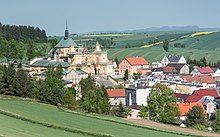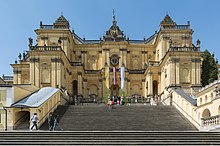Wambierzyce
| Wambierzyce | ||
|---|---|---|

|
|
|
| Basic data | ||
| State : | Poland | |
| Voivodeship : | Lower Silesia | |
| Powiat : | Kłodzko | |
| Geographic location : | 50 ° 29 ′ N , 16 ° 27 ′ E | |
| Residents : | 1200 | |
| Postal code : | 57-411 | |
| Telephone code : | (+48) 74 | |
| License plate : | DKL | |
| Economy and Transport | ||
| Street : | Polanica-Zdrój - Radków | |
| Next international airport : | Wroclaw | |
Wambierzyce (German Albendorf ; Czech: Vambeřice ) is a Marian pilgrimage site in Poland . It belongs to the Powiat Kłodzki of the Lower Silesian Voivodeship and is located at the northeastern foot of the Heuscheuergebirge , four kilometers southeast of Radków ( Wünschelburg ), to whose municipality it belongs.
history
Albendorf was first mentioned in 1330 as "Alberti villa". It belonged to the Glatzer Land , with which it shared the history of its political and ecclesiastical affiliation from the beginning. It originally consisted of three knights' seats ( Nieder-, Ober- and Berghof ) and a Freirichtergut . These four estates mostly had different owners ( von Zischwitz, von Solz, von Pannwitz, von Mülau, von Hoferburg ) until they were acquired after 1677 by the knight Daniel Paschasius von Osterberg , heir to Niederrathen . His son and heir Johann Anton von Osterberg was raised to the baron status in 1712 . In 1715 he sold Albendorf with the three knights' seats, the Freirichtergut and the brewery bar to the imperial count Franz Anton von Götzen on Eckersdorf . After his son Johann Joseph Reichsgraf von Götzen died in 1771 without heirs, his three sisters inherited the property and in 1780 the Reichsgrafen von Magnis .
After the First Silesian War in 1742 and finally with the Peace of Hubertusburg in 1763, Albendorf came to Prussia together with the County of Glatz . After the reorganization of Prussia, it belonged to the province of Silesia from 1815 , which was divided into districts. The district of Glatz was responsible from 1816–1853, and the district of Neurode from 1854–1932 . After its dissolution in 1933, Albendorf was again part of the Glatz district until 1945. On March 27, 1874, the Albendorf district was formed, which consisted of the rural communities Albendorf and Kaltenbrunn and the Albendorf estate district.
As a result of the Second World War , Albendorf fell to Poland in 1945 and was renamed Wambierzyce based on the Czech name Vambeřice . The German population was expelled . Some of the newly settled residents were displaced from eastern Poland . 1975-1998 Wambierzyce belonged to the Wałbrzych Voivodeship ( Waldenburg ).
History of the pilgrimage church
According to legend, the Marian pilgrimage goes back to the 13th century, but is only documented at the beginning of the 16th century. Albendorf was originally a branch church of Wünschelburg and received its own pastor around 1400. Because of the increasing number of pilgrimages, the then landlord Ludwig von Pannwitz had a larger stone church built instead of a wooden church that had been destroyed in the Hussite Wars , which was inaugurated in 1512. In the course of the Reformation , the feudal lords appointed a clergyman of the Augsburg Confession from 1563 to 1623 . As a result, the tradition of pilgrimages was lost and was only gradually resumed around 1660. The landlord Daniel Paschasius rendered great services to its revival. At his instigation, the Archbishop of Prague, Johann Friedrich von Waldstein , elevated Albendorf, which had belonged to Wünschelburg as a branch church since 1623, to an independent parish. It comprised the places Albendorf, Niederrathen, Kaltenbrunn and the colonies Hirschzunge, Leeden and Part New World. Since the church at that time no longer met the needs of a pilgrimage church, an extension with chapels and walkways should be tackled after the elevation to the parish, which would have been technically difficult and associated with great expense. It was not until 1695 that the new building of the three-aisled basilica began, the completion of which took almost 15 years. It was inaugurated on July 12, 1710, but had to be closed in 1715 due to dilapidation.
The current baroque pilgrimage church "Mariä Heimsuchung" was founded in 1716–1721 by the landlord Count Franz Anton von Götzen. It was built according to the plans of an architect from Kilian Ignaz Dientzenhofer's area , who is not known by name . You can get to it via a wide staircase with 33 steps. The center of the church is the oval Mercy Chapel with the baroque high altar, to which a small shrine with the Gothic figure of the Holy Mother of God of Albendorf was added above the tabernacle . The high altar and pulpit were made by the Viennese sculptor Karl Sebastian Flacker , who ran a sculpture workshop in Glatz . In 1936 the church was raised to the rank of papal minor basilica . Many thousands of pilgrims - also from Bohemia and Moravia - came and still come to the Albendorfer Madonna every year.
Calvary
After a pilgrimage to the Holy Land , Daniel von Osterberg had a calvary built on the hill opposite the pilgrimage church between 1683 and 1709 with several chapels and monuments depicting scenes from the passion of Jesus. In the chapels on the hill “Mount Sinai” to the south, representations from the Old Testament can be seen. Because of this Jerusalem complex, Albendorf is also known as the "Silesian Jerusalem".
Community partnerships
- Suchý Důl , Czech Republic
Personalities
- Daniel Paschasius von Osterberg (1634–1711), landlord and patron of the Albendorf pilgrimage site.
- Joseph Knauer (1764–1844), Archbishop of Breslau, was pastor in Albendorf from 1794–1814.
- Ignaz Reimann (1820–1885), the creator of the popular Christmas fair, was born in Albendorf.
- Emanuel Zimmer (1866–1935), consistorial councilor and pastor of Albendorf, is the author of 14 historical plays from the history of the place of pilgrimage and a chronicle of Albendorf.
- Arno Herzig (* 1937), German historian of the early modern period.
literature
- Arno Herzig , Małgorzata Ruchniewicz : History of the Glatzer Land . Hamburg-Wrocław 2006. ISBN 3-934632-12-2 , pp. 171–175.
- Joseph Kögler : The chronicles of the county Glatz . Revised by Dieter Pohl. Volume 5, ISBN 3-927830-19-4 , therein: Documented history and description of the allodial rule Albendorf pp. 21–65.
- Hugo Weczerka (Hrsg.): Handbook of the historical places . Volume: Silesia (= Kröner's pocket edition . Volume 316). Kröner, Stuttgart 1977, ISBN 3-520-31601-3 , pp. 1-2.
- Dehio Handbook of Art Monuments in Poland, Silesia , Munich / Berlin 2005, ISBN 3-422-03109-X , pp. 992–994.
- Emanuel Zimmer: Albendorf, its origins and its history . Wroclaw 1898.
- Joseph Tokarz: Albendorf the Silesian Jerusalem . Wünschelburg 1934.
- Cosmus Flam : The pilgrimages of Daniel Paschasius von Osterberg and how he built up the Silesian Jerusalem in Albendorf to the glory of God . Bergstadtverlag Wilhelm Gottlieb Korn , Breslau 1935.
- Aloys Bach : Documented church history of the Graffschaft Glaz [sic]. Wroclaw 1841.
- Paul Preis: Music and theater life in the city and district of Glatz . Part 2, published by Stadt Lüdenscheid 1969.
Web links
- Historical and current recordings of the Kalvarienberg
- Historical general view
- http://www.grafschaft-glatz.de/reisen/fuehrer/index.htm
- Förderverein Albendorf eV
- Albendorf - the Silesian Jerusalem A contribution by the church historian Rudolf Grulich






